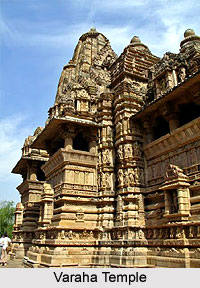 Varaha temple is located at the front of the Lakshmana temple facing the west. It is an open pavilion with a pointed roof, enshrining the icon of Varaha, the third incarnation of Lord Vishnu. The Varaha image dates to about AD 950 and was possibly installed by the Chandella king Yashovarman as a celebration of victory over his Pratihara overlord. The massive Boar, measuring 2.66 m. by 1.75 m., is carved out of a single piece of solid yellow sandstone and is canopied by an exquisite lotus ceiling.
Varaha temple is located at the front of the Lakshmana temple facing the west. It is an open pavilion with a pointed roof, enshrining the icon of Varaha, the third incarnation of Lord Vishnu. The Varaha image dates to about AD 950 and was possibly installed by the Chandella king Yashovarman as a celebration of victory over his Pratihara overlord. The massive Boar, measuring 2.66 m. by 1.75 m., is carved out of a single piece of solid yellow sandstone and is canopied by an exquisite lotus ceiling.
The architecture of this temple is comparatively simple which stands on 14 pillars which support a high pyramidal roof capped with a Kalash. Along with its magnificent image of Varaha it has columned halls with balconies, an entrance porch and the inner sanctum. The shrine is made of sandstone.
Sculpture of Varaha Temple
This magnificent Khajuraho sculpture in the round is positioned in the centre of the shrine with space for devotees to circumambulate. This divine animal carries more than 675 miniature figures on its body, in twelve neatly carved rows. These figures depict all the important divinities of the Hindu pantheon, including Lord Ganesha, the seven Mothers, the seven sages, the eight Guardians of Space, the nine planetary divinities, the river goddesses, the seas, the Rudras, and the different forms of Vishnu. There was also an image of the Earth Goddess, which is now missing. Varaha is depicted in art as having a boar`s head on a man`s body. In the latter form he has four arms, two of which hold the wheel and conch-shell. The other two hold a mace, sword or lotus or make a gesture of blessing. The Earth is held between the tusks of the boar. The sculpture carved between nose and mouth depicts goddess Saraswati who has Veena in her arms
This article is a stub. You can enrich by adding more information to it. Send your Write Up to content@indianetzone.com











